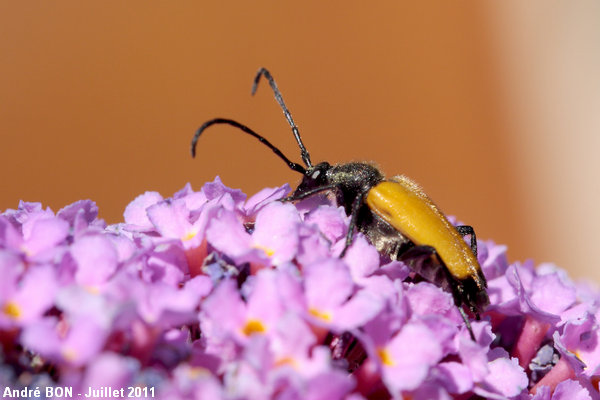



| Brachyleptura fulva (De Geer, 1775) |




|
|
Scientific name: Brachyleptura fulva (De Geer, 1775) Common name: Other names: Other scientific names: Paracorymbia fulva, Stictoleptura fulva, Corymbia fulva. French name: Lepture fauve Order: Coleoptera Family: Cerambycidae Wingspan : 9 to 14 mm. Females are slightly larger than males. Biotope: Forests, woodland edges. Adults, which only live during two or three weeks, can often be observed on Umbelliferae flowers, Daisy flowers or Bramble flowers. Geographic area: Southern part of western Europe, north to southern England and east to Turkey. Observation period : May to September. |
Brachyleptura fulva shows tawny subtriangular elytra with a black tip. The legs, the pronotum and the antennae are black. The completely black antennae enable to tell Brachyleptura fulva apart from Brachyleptura maculicornis whose antennae are yellow at the base of articles 4 to 8 and from Brachyleptura hybrida whose antennae are ringed with yellow starting at the 4th article. The completely black legs enable to tell Brachyleptura fulva apart from the Red Longhorn Beetle (Stictoleptura rubra) whose tarsi and tibiae are yellow or reddish. The head is wider than the pronotum on longicorn Beetles of the Anastrangalia genus while it is smaller on Brachyleptura fulva. The underside of the body is striped with thin yellow lines. Larvae grow in deciduous wood. |
| [To know more about the Brachyleptura fulva] [Next picture] [Top] |

|
I have observed this Brachyleptura fulva on the Buddleia. |
| [To know more about the Brachyleptura fulva] [Next picture] [Previous picture] [Top] |

|
Other angle of view. |
| [To know more about the Brachyleptura fulva] [Next picture] [Previous picture] [Top] |

|
I have shot this picture while I was testing a macro photo flash diffuser (with no great success in fact). I was rather focused on the photo parameters than on the insect. Trying to identify this species some time after was finally a very interesting task. The result, based on the colour of the legs of the antennae and the size and shape of the head is not 100% sure but was confirmed as highly probable by an expert. |
| [To know more about the Brachyleptura fulva] [Previous picture] [Top] |

|
Brachyleptura fulva on an Umbelliferae flower. |